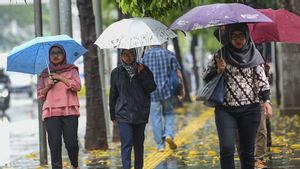JAKARTA - The Eijkman Institute for Molecular Biology reports that two new variants of the corona virus from Indonesia, namely B1466.2 and B1470, have spread to a number of provinces in the country.
"There are 1,225 cases of variant B1466.2 and 531 cases of B1470 in Indonesia," said the Director of the Eijkman Institute for Molecular Biology, Prof Amin Soebandrio, who was confirmed by telephone, reported by Antara, in Jakarta, Thursday, August 5.
He stated that the B1466.2 variant was first discovered in November 2020 in West Java, while the most reported ones appeared in the provinces of DKI Jakarta and West Java.
While the B1470 variant has reached 531 cases since it was first discovered in East Java in April 2020. The most reported cases are in the provinces of Bali and West Java.
The Professor of Clinical Microbiology said that various scientific publications showed that the local variant was not yet classified as a "Variant of Concern" (VOC) or Variant of Interest (VOI) which is being monitored by the World Health Organization (WHO).
However, Amin still reminded the public to remain aware of the local variant, considering that the number of cases had dominated a number of regions.
"WHO only reminds us that there are many Indonesian variants, which dominated several months ago. So we must remain vigilant because it has several mutation patterns that are also present in VOI. Currently, none of the Indonesian local variants are included in VOI or VOC "Based on WHO guidelines, he said, viruses can be classified as VOCs or VOIs if they meet one or a combination of four characteristics.
First, the most widely associated is the speed of transmission of the virus. "So the mutations that occur cause the virus to spread more quickly. It can bind to receptors on human cells more strongly so that the virus enters the cell more quickly and is then translated into quickly infectious," he said.
The second trait, whether the virus is more difficult to diagnose. "This means that the sensitivity of the PCR test has decreased," he said.
The third trait, the virus causes unusual clinical symptoms, such as redness of the skin or other symptoms that do not appear in other variants or cause premature death, Amin said.
The fourth trait is that the virus is not responsive to antibodies formed after infection in survivors, after vaccination, or in therapy patients. "People who are already sick are sometimes given monoclonal antibodies that reduce their sensitivity to some VOCs," he said.
The VOI and VOC variants have almost the same properties. However, the criteria for the VOC virus is considered more virulent because it can trigger symptoms of severe illness.
The English, Chinese, Japanese, Arabic, and French versions are automatically generated by the AI. So there may still be inaccuracies in translating, please always see Indonesian as our main language. (system supported by DigitalSiber.id)













